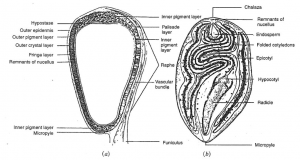Technically, a seed in cotton is a fertilized ovule that may or may not mature into a full grown seed. Seed development can be divided into three stages: enlargement, filling, and maturation. Seed development is strongly related to potassium availability. In about three weeks, the fertilized ovule develops the size of a full grown seed. During the next three weeks, the seed accumulates oil and proteins in the embryo during the filling stage. The maturation stage is characterized by significant physiological processing, including hardening of the seed coat. Seed size varies greatly among species and varieties. Seed size also varies within a variety. The average length and width of upland cottonseed is about 10 mm x 6 mm. G. barbadense seeds are smaller than G. hirsutum seeds, and they are mostly naked or have less fuzz. G. arboreum and G. herbaceum seeds are even smaller than G. barbadense seeds, but they are fuzzy. Seed index is the weight of 100 fuzzy seeds. G. hirsutum varieties have 7,000 to 8,000 seeds per kilogram. Unfertilized ovules make up the majority of motes, but some fertilized ovules may abort and form larger motes of various sizes. Seed can be stored for over five years if the moisture level is less than 10% and there is good aeration. The period of safe storage decreases with the increase in seed moisture content. Seed developed during humid conditions is more prone to deterioration. Seed is harvested soon after boll opening has a dormancy period called the “quality conditioning” period. Cotton seed is usually dormant for 3-4 weeks.

Abscisic acid inhibits germination and the rapidity of germination. The appropriate depth for planting cottonseed is 3-4cm. The germination process does not begin unless moisture is absorbed into the seed. If enough moisture is available, the radical emerges through the micropylar end of the seed in 2-3 days to form a root. Micropyle is a minute hole at the tip of the seed. The hypocotyl is the stem tissue between the radical and cotyledons as soon as the radical is formed, hypocotyl cells expand and push the cotyledons out of the ground, the germination process is slow under low soil temperatures for optimum germination under field conditions, and soil temperature must be at least 60°F. At least 50-60 heat units are required for a seedling to emerge from the soil under optimum conditions in the field. The germination process is completed in about 6-8 days.

The cotton plant has a tap root system. The root has the primary function of absorbing and transporting water and nutrients from the soil to the plant parts and anchoring the plant. The radical forms the primary root that grows downward into the soil. The size of the root depends on the physical texture of the soil, soil fertility, soil temperature and the amount of water in the soil. The root can go deeper than three meters the total root length varies by varieties and species in addition to growing conditions. On average, roots make up one-fifth of the dry weight of a plant. Small fibrous roots start to die as the plant enters into its heavy boll-load stage and beyond. Roots grow rapidly during seedling development and nearly attain their maximum length by the time the plant enters the reproductive stage. Root depth is almost six times the height of the shoot in thirty days after planting at this stage the lateral growth is only 2, 5 to 3 times the height of the plant. In most cultivated varieties, 40% of the water needed to absorb by the top one-quarter of the root system, 30% in the second quarter, 20% in the third quarter and only 10% in the fourth quarter.
This article is jointly authored by Muhammad Nazim-Department of Agronomy, University of Poonch Rawalakot, Azad Kashmir, Pakistan, Dr. Zahoor Ahmad-Cholistan Institute of Desert Studies, The Islamia University of Bahawalpur, Pakistan and Dr. Muqarrab Ali-Department of Agronomy, Muhammad Nawaz Sharif, University of Agriculture Multan, Pakistan.